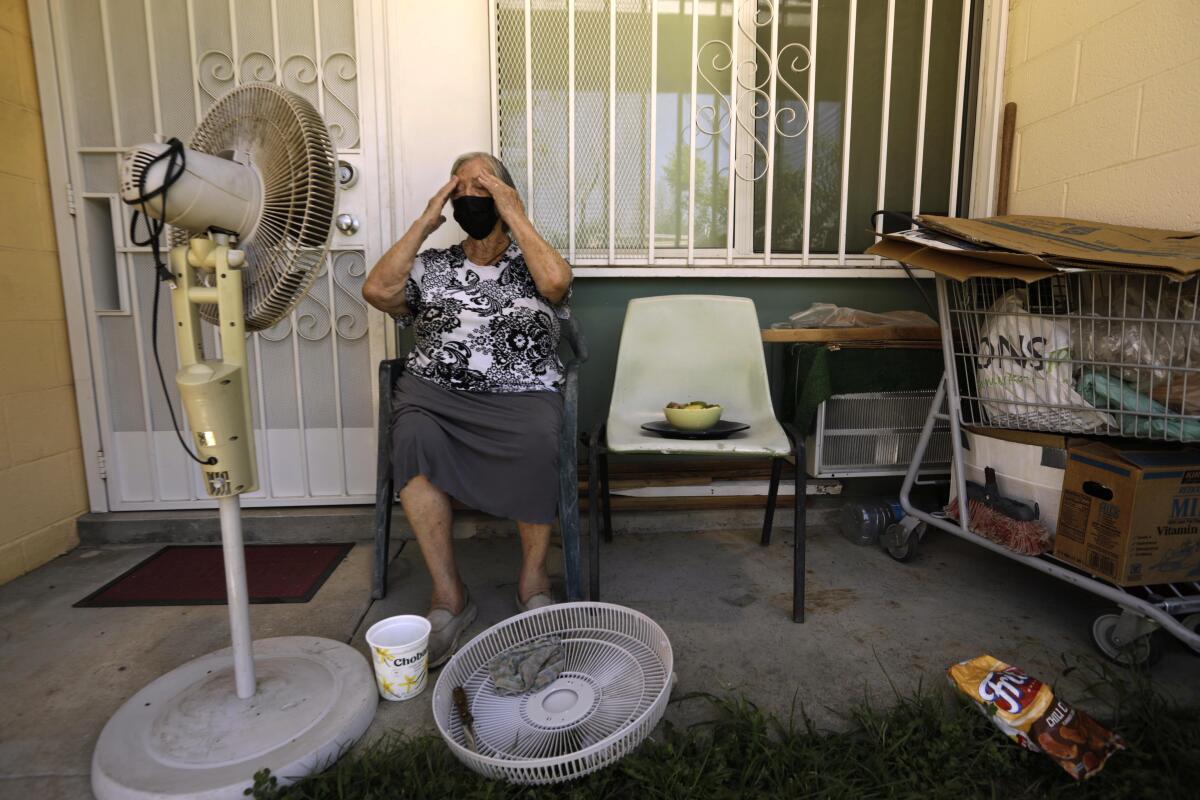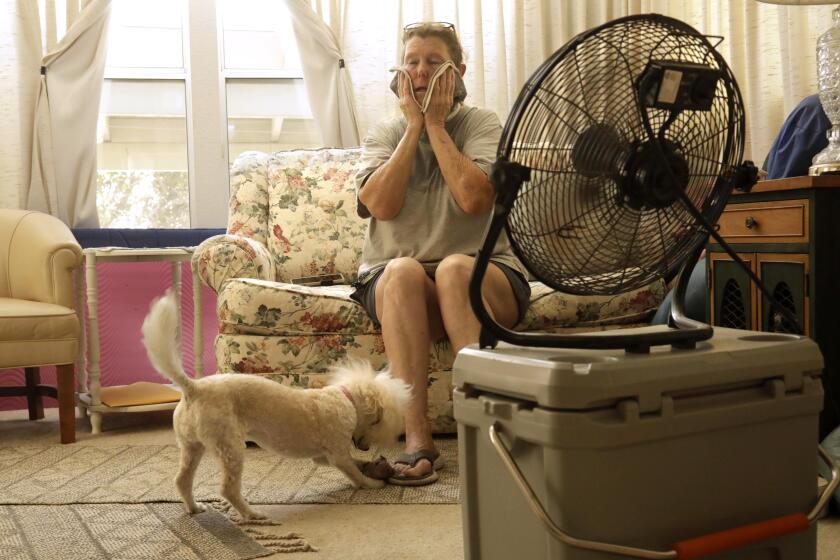California considers ranking heat waves after Times investigation into extreme heat deaths

- Share via
California could become the first state in the nation to institute a ranking system for heat waves, much the way weather authorities categorize hurricanes, or how fire and air quality officials warn of wildfire and pollution risks.
The move, announced on the last day of the United Nations climate talks in Scotland, is intended to raise awareness of the deadly effects of extreme heat events, which experts say kill more people than any other climate-driven hazard and are increasing in frequency and intensity as the planet warms.
“Without a way to rank heat waves, we treat extreme heat more like a weather story when it’s really a public health crisis,” said California Insurance Commissioner Ricardo Lara, who will sponsor a bill to develop the ranking system. The bill was jointly written by Assemblymembers Luz Rivas (D-North Hollywood) and Eduardo Garcia (D-Coachella), who plan to introduce it after the Legislature reconvenes in January. Sen. Henry Stern (D-Malibu) will be a principal co-author.
It started in late May as I began to pull images out of the ether.
“There are a lot of vulnerable people, especially the elderly, that stay in their apartment, they’re not informed, they don’t know what the risk is, and they end up dying because either they don’t have an air conditioner or they may hesitate to run their air conditioner because they can’t pay the electric bill,” Rivas said. “And we can’t continue to let that happen and not be prepared.”
The announcement comes after a Times investigation revealed that heat probably caused about 3,900 deaths in California over the previous decade — six times the state’s official tally — and that the undercounting has contributed to a lack of urgency in confronting the crisis. The effects of these worsening heat waves fall disproportionately on the poor and communities of color, the series found.
It also comes on the heels of a report by Lara’s climate insurance working group that recommended the ranking of heat waves in order to warn communities and encourage policymakers to craft prevention strategies and risk-reduction measures.
Though the California bill will only propose ranking heat waves, it’s possible that the state could also consider a system of naming heat waves in the future, the legislators said.
California chronically undercounts the death toll from extreme heat, which disproportionately harms the poor, the elderly and others who are vulnerable.
“Heat is the silent killer. How can you solve it if people don’t know about it and understand it?” said Kathy Baughman McLeod, director of the Adrienne Arsht-Rockefeller Foundation Resilience Center at the Atlantic Council and chair of the Extreme Heat Resilience Alliance. The global coalition of cities, nonprofits, scientists, companies and government agencies, of which Lara is a member, has been developing a worldwide standard for naming and ranking heat waves and recently announced that Seville, Spain, would be the first city to adopt it. Athens is also considering doing so, Baughman McLeod said.
The state could also adopt other ways of dealing with the escalating heat, including appointing a chief heat officer to coordinate its response, as the cities of Miami and Phoenix have done. Most recently, Los Angeles also announced it would take this step, with the City Council on Wednesday greenlighting a motion by Councilmember Paul Krekorian to create the position.

“It’s imperative that the city have a detailed plan in place to address this ongoing climate catastrophe,” Krekorian said in a statement.
Paved surfaces, tree cover, and home construction quality can make the difference between heat waves being an inconvenience or a threat to your life.
The Extreme Heat Resilience Alliance is recommending that California adopt three categories of heat waves, with No. 3 being the most threatening and No. 1 the least, Baughman McLeod said. The categories will be based on both heat intensity and health impacts, taking into account temperature and humidity, as well as excess mortality data specific to a community, she said.
The warning system will include advice for what a community should do when it experiences a heat wave of a certain category, Baughman McLeod said. That might include suggestions that local governments suspend power shutoffs to people who haven’t paid their bills, allowing them to run air conditioners, or send urban search-and-rescue teams door to door to check on vulnerable community members, she said. Residents might also be advised to check on heat-susceptible relatives, limit outdoor activity or seek shelter at air-conditioned community centers.
Alongside the new legislation, the state Department of Insurance plans to calculate the hidden cost of heat waves, which will look at the so-called protection gap between losses that are covered by insurance and those that aren’t, Lara said. The study will take into account costs to local governments, such as losses from uninsured people suffering heat-related illnesses and disruptions to electricity services, he said.
“Currently we don’t track these losses like we do with any other major climate events such as wildfires or hurricanes,” he said, adding that calculating the gap is the first step toward closing it.
Read all of our coverage about how California is neglecting the climate threat posed by extreme heat.
Lara, Rivas and Garcia said they decided to move forward with the legislation to rank heat waves after attending the COP26 summit in Glasgow and realizing two things: Other nations are surpassing California’s efforts to deal with extreme heat. Also, given the lack of progress toward reducing global emissions, this year will probably be the coolest any of us experience in our lifetimes, they said.
“We can’t ignore this any longer, and we have to incorporate it into our emergency preparedness actions,” Garcia said. “We are not going to see cooler days, only much, much hotter days.”
The issue is intensely personal for all three officials. Garcia grew up in the Coachella Valley, where temperatures at times surpass 125 degrees. As a representative for the area and the neighboring Imperial Valley, he has seen his constituents scramble to figure out how to connect to generators to power life-saving medical devices when extreme heat has disrupted the electrical grid, he said.
Rivas, a native of the east San Fernando Valley, which she now represents, recalls her mother having to take her to the mall or grocery store when it got hot because her family didn’t have air conditioning.
And Lara used to sleep in the backyard of his childhood home in East Los Angeles to escape the heat, something he thought all families did during the summer, like camping.
“It’s closing the circle in terms of us now being in these positions, to make sure no other families have to go through what we’ve personally gone through and what our constituents are going through now,” he said.
They also hope that given California’s presence on the global stage — the state has the world’s fifth-largest economy and is widely seen as a leader in the fight against climate change — the legislation can serve as an example.
“This is a huge shot in the arm for other communities to pick this up,” Baughman McLeod said.
More to Read
Sign up for Essential California
The most important California stories and recommendations in your inbox every morning.
You may occasionally receive promotional content from the Los Angeles Times.















